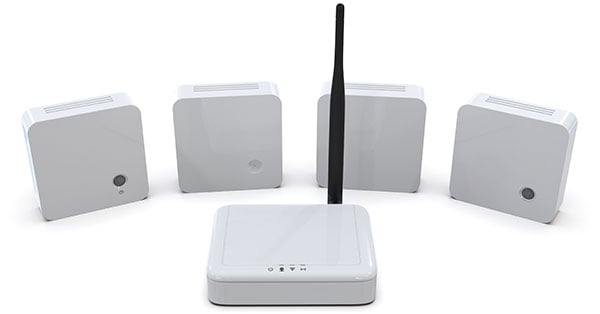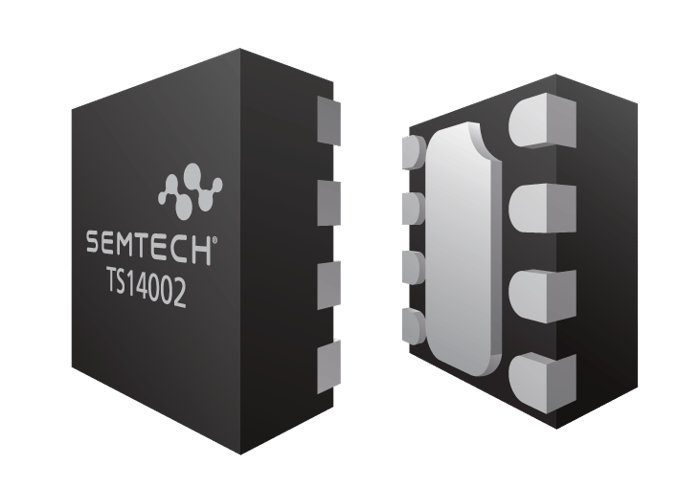17 May, 2023 3 min read
モノのインターネット (IoT) は、ローカルまたはクラウドのゲートウェイ/サーバーとデータと命令を共有および交換するために、インターネットに接続されたセンサーとデバイスのネットワークです (図1)。IoTセンサーはIoTエコシステムの重要な要素であり、あらゆる種類のユースケースと場所特有の制約にサービスを提供し、接続するために、ワイヤレステクノロジーを使用する例が増えています。これらのセンサーは、リアルタイムデータを収集してゲートウェイと共有し、処理のためにクラウドベースのアプリケーションに転送したり、「エッジ」でのよりよい意思決定を可能にしたり、プロセスを自動化したりします。LoRaWAN®などのワイヤレス通信プロトコル、セルラー、BluetoothやWi-Fiは、こうしたデータの伝送に役立ちます. Many IoT wireless networks communicate with hundreds of sensors in inaccessible areas. One of the main requirements of a wireless sensor is to collect accurate data with minimal maintenance and run on a small amount of battery power for months and even years in the field. In some applications, IoT sensors are required to run on batteries for years as they are installed in locations that are hard to access, such as underground. Because of this, it has become critical to find ways to extend the battery life of the sensors. Using an LDO (Low-Dropout) voltage regulator for the power management of these low-powered sensors can be beneficial in their creation and help to realize these low-power solutions.
 Figure 1. IoT sensors and gateway
Figure 1. IoT sensors and gateway
An LDO is a type of voltage regulator that is commonly used to regulate voltage in electronic circuits. An LDO specifically regulates the output voltage to a value only slightly lower than the input voltage, typically on a few hundred millivolts of voltage drop. LDO can operate with a much smaller voltage difference between the input and output than other voltage regulators. A low to tiny voltage drop implies minimal power consumption by the LDO and maximizes power to the load, delivering clean, low-noise power to the sensor circuit. At the same time, it can respond instantly to load transients. An ultra-low quiescent current is another essential feature of an LDO. In an IoT sensor, as shown in Figure 2, the LDO powers the circuit at different load conditions; at a high load when it gathers data and at a low to a no-load state when it performs minimal activities or remains idle in sleep mode. A low quiescent current means low power consumption under low or no-load conditions, which helps extend the sensor battery's lifetime.
.jpg?width=700&height=251&name=Figure2%20(1).jpg) Figure 2. An application of an LDO
Figure 2. An application of an LDO
Semtech's nanoSmart® TS14002 is an LDO ideally suited for IoT sensors. It has power management capabilities that help preserve battery life and has a tiny solution footprint. TS14002 works within an input voltage range of 2.5V to 5.5V and can regulate current loads as high as 150mA. It exhibits an ultra-low quiescent current of only 20nA (typical) and only 100pA (typical) in disabled mode. Despite this ultra-low quiescent current, TS14002 presents a superb Power Supply Rejection Ratio (PSRR).
The critical elements of TS14002, as shown in Figure 3, include a P-channel MOSFET, an error amplifier that controls the MOSFET, a voltage reference, and a control block. The source of the P-channel MOSFET is connected to the input voltage. The feedback network senses the output voltage, and the error amplifier compares it with the voltage reference. Suppose the output current increases, the output voltage drops, and the gate voltage reduces with respect to the source. The conduction level of the P-channel MOSFET increases, and the output voltage rises to the previous voltage. This is how TS14002 regulates the output voltage. The P-channel MOSFET is preferred as a pass element over the N-channel MOSFET. A charge-pump circuit is usually needed if an N-Channel MOSFET is used as the pass transistor. The charge-pump circuit generates noise during its operation. The noise would pass through the internal circuit to the output of the LDO, increasing the noise level. The TS14002 features extremely low output noise since a P-Channel MOSFET has been adopted as the pass transistor. The meager noise output makes the TS14002 very suitable for sensor applications since more accurate outputs can be obtained from those sensors in harsh environments.
.jpg?width=700&height=386&name=Figure3%20(1).jpg) Figure 3. Block diagram of TS14002
Figure 3. Block diagram of TS14002
TS14002 is available in ten fixed output voltages, ranging from 1.2V to 4.2V. Custom values are also available between 1.2V to 4.2V in 100mV increments. Bundled in a tiny 8-pin DFN package with a 2 x 2mm nominal dimension, as shown in Figure 4, TS14002 delivers a dropout voltage of 100mV at 40mA load current when the output voltage is 3V. Other features of the TS14002 include accurate output regulation and over-current protection. The DC load regulation is from 0.02mA to 150mA, and the output current is 1% (Typical). The TS14002 has an operating temperature range of -40 to 85˚C.
 Figure 4. TS14002 package (DFN-8 2x2mm)
Figure 4. TS14002 package (DFN-8 2x2mm)
Key Specifications of TS14002:
Input voltage range: 2.5V to 5.5V
Output voltage range: 1.2V/1.5V/1.8B/2.4V/2.5V/2.7V/2.8V/3.0V/3.1V/3.3V/3.6V
Quiescent current: 20nA (Typical)
Output current: 150mA (Max)
Output bypass capacitor: 2.2uF (Typical)
The number and complexity of IoT sensors is increasing rapidly across a vast range of market segments, from wearables to public utilities. Competent linear regulators are becoming essential to manage power and prolong the battery life efficiently of these devices. Semtech's low-power LDOs are designed to power a broad range of IoT sensors and modules with excellent efficiency and shallow quiescent current. To learn more about Semtech power products, visit our website.
Semtech®, the Semtech logo, LoRa®, LoRaWAN, and nanoSmart® are registered trademarks or service marks of Semtech Corporation or its affiliates. Other product or service names mentioned herein may be the trademarks of their respective owners.
イノベーションを受信トレイにお届けします。当社のブログに登録して、Semtechの最新情報を入手してください。